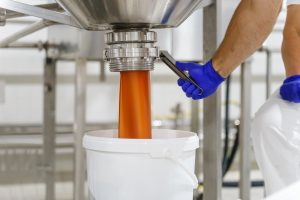
Reliable material flow is critical for efficient bulk material processing. Material blocks slow down production and waste time and money. Stagnant material can also be contaminated or affect batch consistency.
So, the biggest challenge of bulk material processing is to achieve on-demand, first-in/first-out material flow. Unfortunately, that is easier said than done.
Why is it hard to achieve reliable material flow?
There is no single, simple formula for achieving good material flow. You have to consider many factors, some of which cannot be controlled or changed.
- Some materials have problematic flow patterns, because of their chemical or molecular structure, weight, and how they react to moisture.
- Cohesive and adhesive force, which cause particles to stick together and block the discharge
- Cohesive strength and internal friction affect how strong the material block is
- Bulk density, which affects how easily it flows because of gravity
- Particle size and shape
- Tendency to absorb moisture
- Angle of repose, which is directly related to the flow rate
- Flow patterns are difficult to predict. Product formulas will include a variety of materials, which all have their own particle characteristics and densities. If a company decides to change its formula it can encounter a material flow problem.
- Some vessels are not designed for efficient material flow. The slope or angle of the vessel and the size and shape of the discharge outlet can affect the rate of flow. Unfortunately, not all equipment is customized for the flow properties of the materials.
- Plant humidity and moisture can affect materials. This is especially true for countries with high humidity or materials that are hygroscopic or have a tendency to attract moisture.
- Material flow problems can occur at any stage of bulk material processing. Some materials can settle and become compact during storage, while others will flow well until it is mixed with other materials.
What are the most common material flow problems?
The most common bulk material processing problems are bridging, ratholing, and segregation.
Bridging occurs when material forms a large arch above the vessel discharge and stops the material flow. It can be caused by large particles interlocking, or smaller particles bonding together because of the moisture, temperature, particle shape, or concentration of fines.
Ratholing occurs when stagnant material builds up on the vessel walls and thus restricting the passage of materials. Aside from slowing down the flow, it also causes material waste and possible contamination.
Segregation is the uneven distribution of components of bulk material because of differences in their physical or chemical properties. This can lead to inconsistent formulas, which can affect product quality and safety.
What can improve material for bulk material processing?
AirSweep eliminates bridging, ratholing, material segregation, and other flow problems. It guarantees on-demand, first in/first out flow, and has lower energy and maintenance costs than other flow aids.
AirSweep is used in thousands of bulk material processing plants worldwide. It is proven effective for even moist, sticky, and heavy materials, and has helped many customers increase production, lower costs, and protect product quality.
Contact us for more information about AirSweep, and how it can benefit your plant operations.





Comments are closed